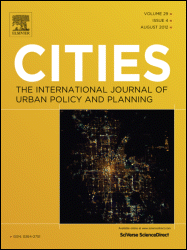|
|
Globalization, regional development, and mega-city expansion in Latin America: Analyzing Mexico City's peri-urban hinterland Adrián Guillermo Aguilar, Peter M. Ward Vol.20 | Núm. 1 | 2003 Cítese como: Aguilar, A. y Ward, P., (2003), Globalization, regional development, and mega-city expansion in Latin America: Analyzing Mexico City's peri-urban hinterland en Cities, 20(1), pp. 3-21. |
|
ABSTRACT This paper examines the transformation of urban space in the periurban areas of Latin American mega-cities.further exacerbing the multi-jurisdictional political divisions that cover a single urban entity. This is against the backcloth of a sharp decline in metropolitan growth rtes, absolute population loss in the city center, and an alleged "polirazation reversal" of national urban patterns. Ir argues that previous approaches have failed to recognize that globally and nationally-derived economic development processes are often vested in these meta-urban peripheries. Using Mexico City as an example, the authors propose a new generric methodology that will allow for a broader definition and analysis of mega-city and large metropolitan development. Data are presented within this new framework that help to unpack the demographic, economic and land-use changes that dynamics of Mexico City's broader urban area. Much of the contemporary vibrancy and dynamics of Mexico City's metropolitan development are occuring in "hot spots" in the extended periphery, wich to date, have rarely been cosidered an integral part of mega-city. Yet thes areas are also some of the principal loci of contemporary globalization processes.
Mega-city, Mexcio City, metropolitan growth, peri-urban transformation, globalization
|






